Location :
Significance of the temple
Sarnath has been a world famous Buddhist site in Varanasi. Lord Buddha preached his first sermon at a deer park. The sermon is known as Dhammachakkapavattana or setting in motions the Wheel of Law in Buddhism. Sarnath gradually became one of the great centres of Buddhism. The great Emperor Ashoka erected magnificent stupas and structures in Sarnath. In 640 AD, the Chinese scholar Huien Tsang who visited Sarnath wrote about the splendour of the city. In 1836, this place was rediscovered and excavated. Sarnath in Varnasi is one of the holiest sites that attract the people from all over the world. The people visit Sarnath to pay homage to the great teacher and to attain spiritual perfection.Buddha's first ever discourse, delivered here at Sarnath, is known in Pali as the Dhammacakkhapavathana Sutta. Other Stupas in Sarnath include the Anattalakhana Sutta and the Saccavibhanga Sutta. The great Buddha's central teaching after his enlightenment centered on the Four Noble Truths which concerns about the meaning of life and even the Noble Eightfold Path which is concerned about the right way to live.
The Great Teacher Buddha spent the rainy season in Sarnath at the Mulagandhakuti vihara. Buddhism flourished in Sarnath as part because of the support of kings and wealthy merchants based in nearby Varanasi. By the 3rd century Sarnath had become an important center for the arts, which reached its zenith during the Gupta period (4th-6th century AD). When Hsuan Tsang visited from China in the 7th century, he found 30 monasteries and 3000 monks living at Sarnath. Sarnath became a major center of the Sammatiya school of Buddhism, one of the Nikaya or Hinayana schools. The presence of images of Heruka and Tara indicate that Vajrayana Buddhism was also practiced here.
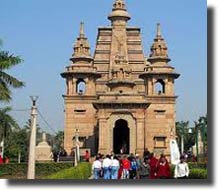
Other places to visit
The Sarnath Temple is embedded with many Stupa worth visiting.
'Dhamek' Stupa
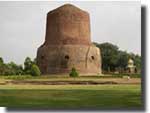
Choukhandi Stupa
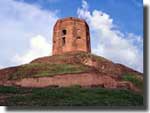
Mulgandha Kuti Vihara
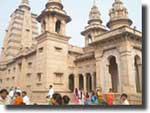
Ashoka Pillar
This pillar was erected by the Emperor Ashoka. The pillar had his edict engraved on it. This stupa is about 15.24 m in height and had four lions as its capital which is now treasured in the archaeology museum. The lion symbolises both Ashoka's imperial rule and the kingship of the Buddha. The four-lion capital was adopted as the emblem of the modern Indian Republic.
Sarnath Museum
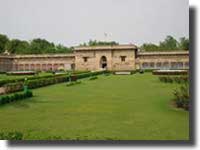
Bodhi Tree
| The sapling of the Bodhi tree was brought from the famous tree in Anuradhapura, Sri Lanka, which in turn originated from the original tree at Bodhgaya, under which the Lord Buddha attained enlightenment about 2,500 years ago. | 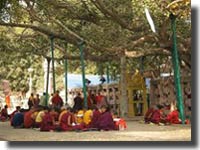 |
Time to Visit
Pleasant time to visit Sarnath Temple is October to March.
Accommodation Facilities at the Temple
Not much accommodation options are available in Sarnath. The more convenient way is to stay in Varanasi, which has accommodation options in all the three different categories.
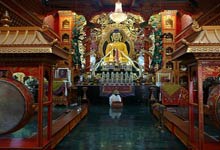 |
Nearby tourist places to Sarnath Temple
Amristar Lucknow Sanchi Varnasi |
One can find Anand Restaurant, Sarnath, Rangoli Garden, Sarnath, Mrigdav Restaurant, Sarnath State Bank of India, Ashapur, Sarnath, Canara Bank, Central Bank, Ashapur |
How to Reach the Temple
- Through Air, Varanasi (Babatpur) Airport is the nearest airport where Commercial flights connect Varanasi to Kathmandu, Delhi, Agra and Mumbai.
- By Railways Varanasi railway station is well connected to important cities of the country.
- By road Sarnath is also well connected to the National Highway No. 29 that also connects Varanasi and Gorakhpur.



